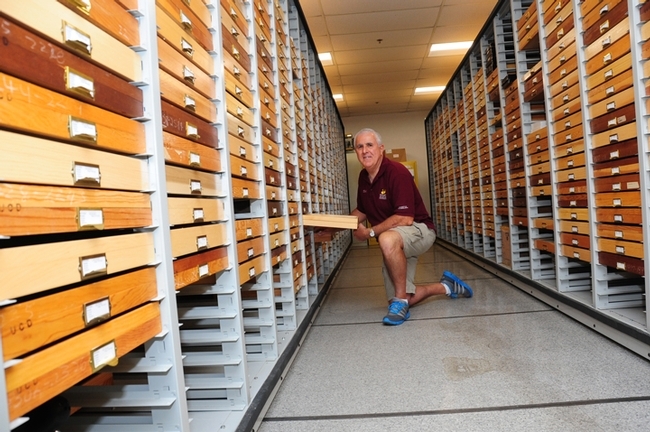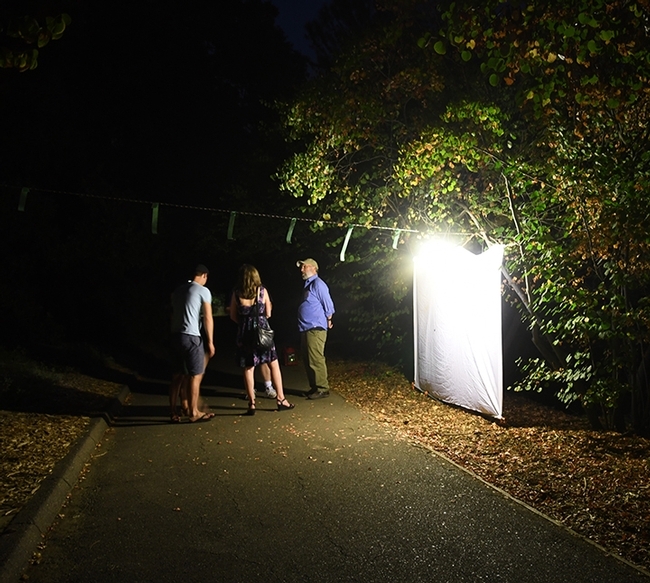- Author: Kathy Keatley Garvey
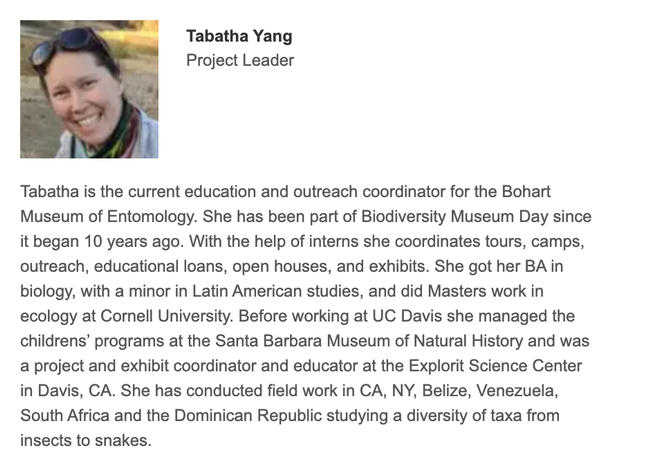
A UC Davis Crowdfunding Project is underway until 11:59 p.m., Feb. 28, with a set goal of $5000. Contributions from $5 on up are welcome.
The Biodiversity Museum Day, free and science-based, traditionally takes place the Saturday of Presidents' Day weekend and involves nearly a dozen museums or collections showing their displays and exhibits to the general public. It's always been an opportunity for campus visitors to talk to the scientists and see the work underway.
However, due to COVID-19 pandemic restrictions and UC Davis policies, this year's event will take place from 11 a.m. to 3 p.m., Sunday, March 6 in the UC Davis Conference Center, 550 Alumni Lane and is geared for undergraduates and other members of the UC Davis community instead of the general public. (The general public can look forward to the UC Davis Picnic Day on April 23, 2022 when many of the same museums and collections are scheduled to be featured.)
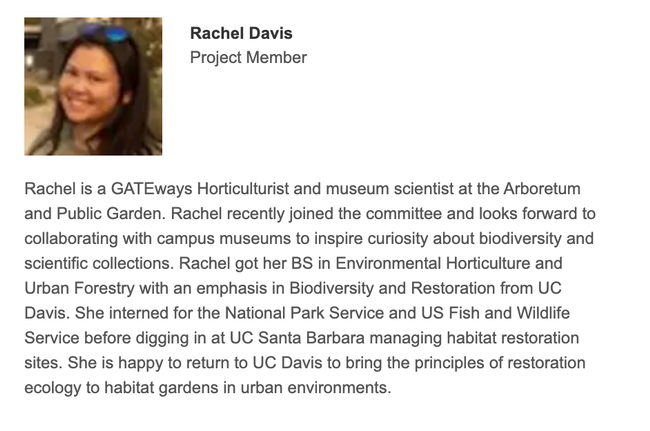
"Last year, throughout the month of February, we offered a virtual 'BioDivDay' with lectures, talks, and demos from experts," they wrote on the Biodiversity Museum Day Crowdfunding Project page. "Your support will enable our 11 collections-- the students, staff and faculty associated with them-- to hold this event again."
"Donations will not only help us sustain the free, in-person event, it will enable our student interns to take science outreach to a whole new level. The goal of our event is to connect people from all walks of life to science and the biodiversity surrounding them. All donors will be recognized on the Biodiversity Museum Day social media accounts with a shout-out post. Your gifts will help us with some of our key expenses that include:
- Volunteer support ($2000)
- Event rentals ($1500)
- Event materials ($1500)"
COVID guidelines for UC Davis,Yolo County and the state of California--including appropriate mask wearing, UC Davis symptom surveys, vaccination records or negativeCOVID tests--will be followed. Side trips or tours of some of the facilities or collections, including the Bohart Museum of Entomology, Botanical Conservatory, Arboretum and Public Garden, and the yeast collection are planned but not yet scheduled.
To donate, access https://bit.ly/3HPhSaA. A donor wall includes the names of contributors.
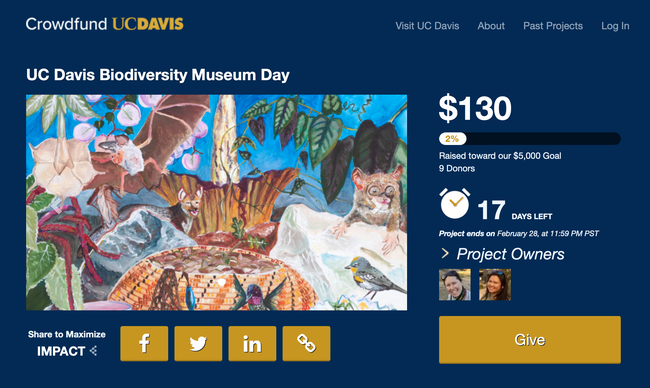
- Author: Kathy Keatley Garvey
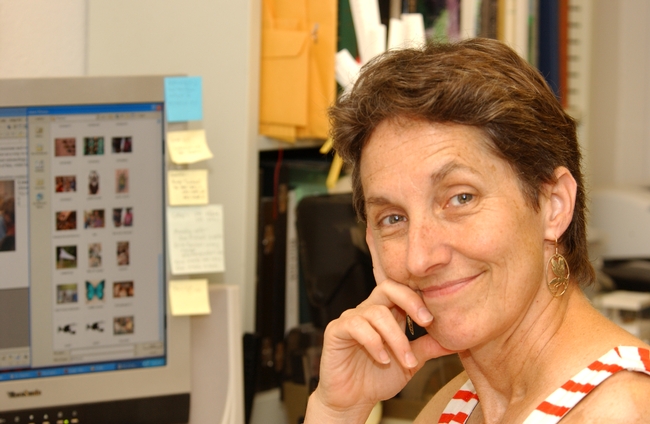
No. Make that “Have insect specimens in portable glass-topped display boxes and will travel throughout Northern California to school classrooms, youth group meetings, festivals, events, museums, hospitals--and more--to help people learn about the exciting world of entomology."
The Bohart Museum of Entomology has launched a CrowdFund project to raise $5000 by 11:59 p.m., Oct 31 to purchase traveling display boxes.
“When COVID halted our in-person outreach programs, we were still able to safely loan these educational materials to teachers,” said Tabatha Yang, the Bohart Museum's education and outreach coordinator.
“Now that UC Davis is open again to students we have all these bright, students on campus with fresh and diverse perspectives,” she said. “We want to support their talent, so the funds we are raising will go to students for the creation of new traveling displays. This fleet of new educational drawers will expand and update what we can offer. Some of our current displays were created 15 years ago! One can only imagine all the places these drawers have been and all the people who have been inspired."
Donate in Someone's Memory. The minimum donation is $5, Yang said. "You can donate in honor or in memory of someone, a place, or an organism, too! There is a map (states and countries) that lights up donor locations. Those of you with a fondness in your hearts for insects, college student experiences, science education, and/or museums, please donate to light up our map!" Access the donation page and map at https://bit.ly/3v4MoaJ
The Bohart Museum of Entomology, a research collection and public museum dedicated to understanding, documenting and communicating terrestrial arthropod diversity, is now celebrating its 75th year. It maintains a robust outreach program that typically connects with more than 10,000 people annually, according to Lynn Kimsey, director of the museum and a UC Davis distinguished professor of entomology.
Portable educational boxes are considered a great way to share the museum experience with others. They are housed in the same specimen boxes that the Bohart scientists use for their research collections. UC Davis students, staff, teachers and scout leaders routinely borrow these materials to enrich their programs.
"Our current educational boxes were created 15 to 20 years ago by staff and students at UC Davis," the scientists related on the CrowdFund page. "After years of wear and tear and new developments in biology, we need to update and create a new suite of display boxes. These displays will not only be scientifically accurate, but they will be intriguing to view by all ages. With every $500 in donations, a student will be able to create a fresh new box, complete with an informational sheet and a short video. The goal of this fundraiser is to provide 10 students the opportunity to create 10 portable educational displays that will enhance the outreach mission of the Bohart Museum and the University of California."
Virtual Tour. The public is invited to access the Bohart's Facebook Live virtual tour for Aggie Spirit Week on Wednesday, Oct. 13. The "Bugology" link is: https://fb.me/e/XKtXPrsB. Plans are to spotlight Professor Kimsey; senior museum scientist Steve Heydon; Lepidoptera collection curator Jeff Smith; and graduate student Socrates Letana (who researches bot flies) and others.
The Bohart Museum, temporarily closed to the public due to the COVID-19 pandemic, is located in Room 1124 of the Academic Surge Building, Crocker Lane. It houses nearly eight million insect specimens, collected from around the world. It is also home to a live "petting zoo" comprised of Madagascar hissing cockroaches, walking sticks and tarantulas, as well as an online gift shop stocked with insect-themed jewelry, clothing, books, posters and other items.
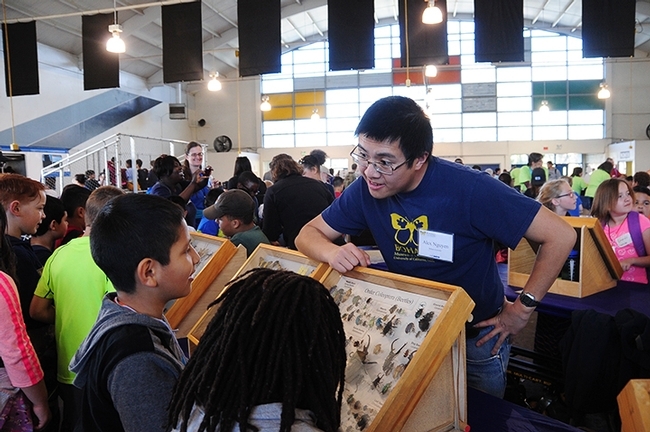
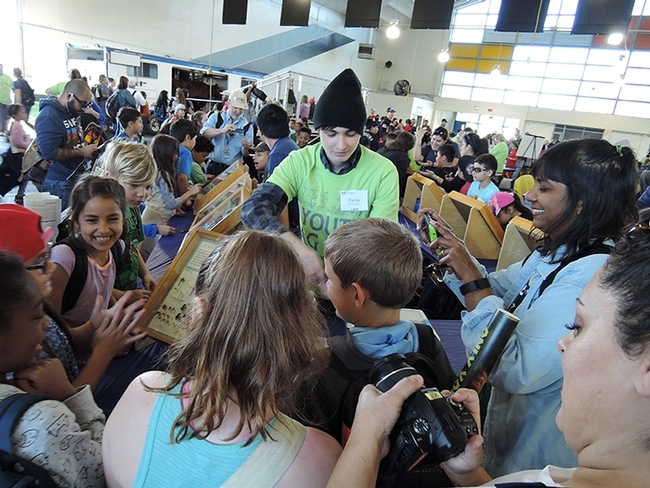

- Author: Kathy Keatley Garvey
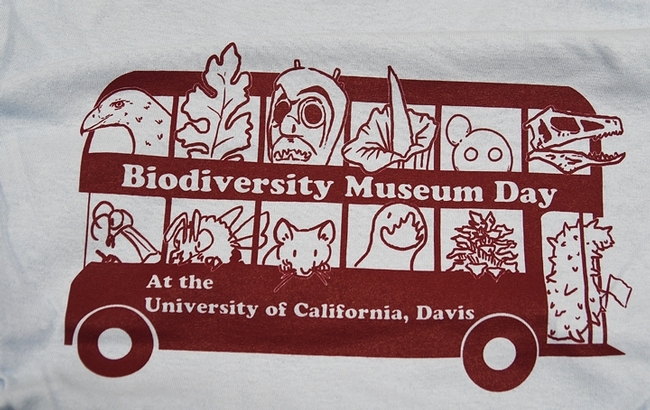
It will not be a day--it will be a month, the month of February.
It will not be a walk-around event--it will be virtual.
Traditionally billed as a “free, educational event for the community where visitors get to meet and talk with UC Davis scientists "and see amazing objects and organisms from the world around us,” it's a science-based event showcasing the diversity of life, according to Biodiversity Museum Day coordinator Tabatha Yang, education and outreach coordinator for the Bohart Museum of Entomology.
Over the last nine years, it took place the Saturday of Presidents' Day weekend. Last year more than 4000 attended.
Information on the event is being posted on the UC Davis Biodiversity Museum Day website as plans unfold. The 12 museums or collections participating in the virtual program this year via Zoom webinars, Facebook programs and YouTube will be:
- Anthropology Museum
- Arboretum and Public Garden
- Bohart Museum of Entomology
- Botanical Conservatory
- California Raptor Center
- Center for Plant Diversity
- Häagen-Dazs Honey Bee Haven
- Nematode Collection
- Marine Invertebrate Collection
- Museum of Wildlife and Fish Biology
- Paleontology Collection
- Phaff Yeast Culture Collection
The live talks and demonstrations and pre-recorded talks and activities are being posted on the Biodiversity Museum Day/Month website.
Live talks will encompass such topics as heliconius butterflies, bees and gardens, orchid bees, plants in the Botanical Conservatory, Asian giant hornets (aka murder hornets), ants, yeasts, mammal specimen preparations and raptors.
Pre-recorded programs will cover bee diversity, millipedes, herbariums and marine life, as well as how to make a bee condo and how to prepare insects (spread the wings of butterflies and moths) for display, among other subjects.
All participating museums and collections have active education and outreach programs, Yang said, but the collections are not always accessible to the public. More information is pending on the website at http://biodiversitymuseumday.edu, and on social media, including Facebook and Twitter, @BioDivDay.
The UC Biodiversity Museum Day/Month program is participating in Crowdfund UC Davis "where alumni, students, parents and friends can make donations to support innovative projects that propel student engagement, new research discoveries, and efforts to expand UC Davis impact on California and the world." The funding program will continue through the end of February.
To donate, click here:
https://crowdfund.ucdavis.edu/project/24310
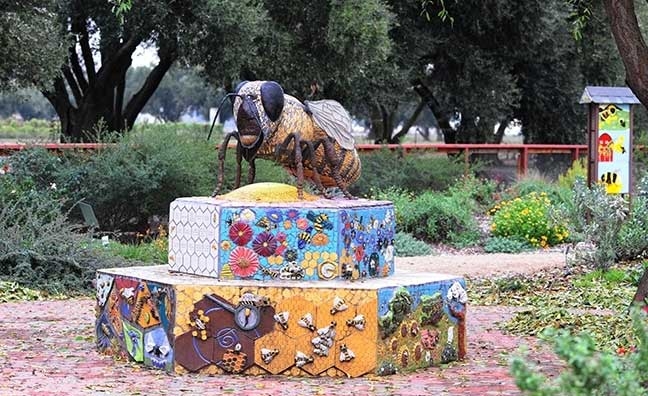
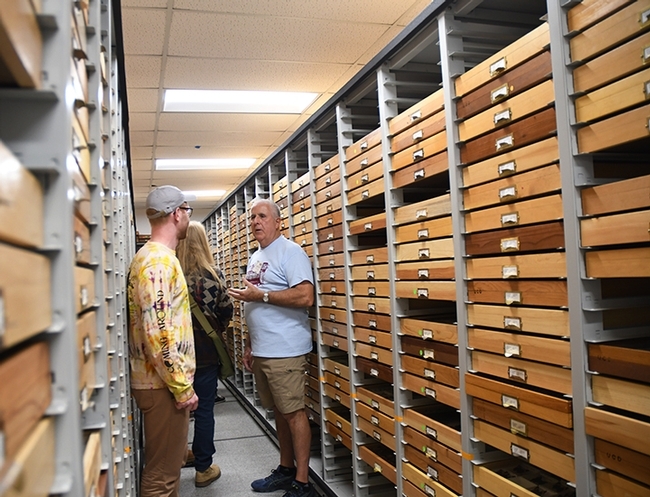

- Author: Kathy Keatley Garvey
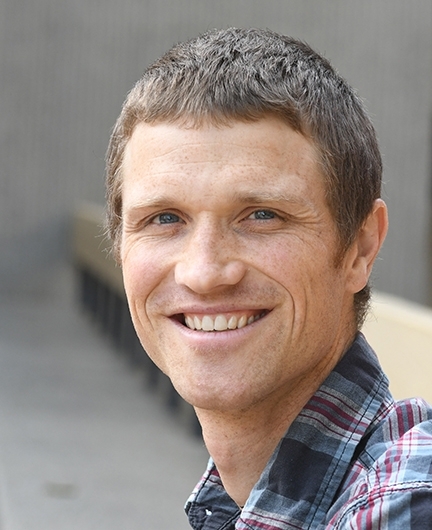
Cooperative Extension agricultural specialist Ian Grettenberger, assistant professor, UC Davis Department of Entomology and Nematology, and his graduate student, Madison "Madi" Hendrick, will discuss the crops, the pests, and the natural enemies or beneficials at a virtual Facebook live session from 11 a.m. to noon, Thursday, Oct 22.
The event, "The Good and the Bad: Insects and Other Arthropods in Agriculture, with a Focus on California Rice and Alfalfa," will be live-streamed on the UC Davis Bohart Museum of Entomology's Facebook page. (Link to Facebook live here). Grettenberger and Hendrick will present short talks and then field questions. No personal Facebook account is required to join the session, which is free and open to the public.
"This is all about the arthropods, both the pests and beneficials that they study in the rice and alfalfa fields," said Tabatha Yang, education and outreach coordinator for the Bohart Museum of Entomology. "Most of the focus is on insects, but tadpole shrimp in rice fields also will be discussed." A virtual family craft activity is also planned.
"I will be discussing some of the insect (or arthropod) problems faced by growers of rice in California and some of the challenges in managing them, Grettenberger said. "In rice, some of the key arthropod pests are tadpole shrimp, which can turn what would have been a lush stand if rice into a poor stand with a lot of floating seedlings. Meanwhile, later in the year, armyworm caterpillars, the larvae of a moth, can chew on rice leaves and destroy plants. I'll discuss some of the ongoing work to better understand and manage these pests."
Grettenberg's fields of expertise include field and vegetable crops; integrated pest management; applied insect ecology, and biological control of pests. (See Spotlight on Ian Grettenberger.) Among his current grants:
- Protection of rice from invertebrate pests
- Insecticide resistant alfalfa weevils in the western United States: Quantifying the scope of resistance and implementing a plan to manage the threat?
- Management of key cotton arthropod pests with insecticides and acaricides, a proactive approach to prepare for the invasion of the tomato leafminer (Tuta absoluta) into California
- Detection, biology and control of the exotic Swede midge (Contarinia nasturtii) for California cole crops
- Management of the western spotted and striped cucumber beetle in melon production
- Biological control of the bagrada bug
- Insecticide resistance monitoring and evaluation of efficacy of current chemical tactics for managing aphids and thrips in lettuce
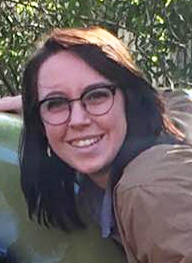
What sparked his interest in entomology? "I had biologist parents, and was drawn into entomology at a pretty young age," Grettenberger said. "I spent plenty of time looking in flowers and turning over logs looking for insects. Once I started thinking about going to graduate school for entomology, I decided to focus on the intersection of agricultural entomology and insect ecology. I wanted to work on applied issues in entomology."
Hendrick, a second-year graduate student in the Grettenberger lab, received her bachelor's degree in iInternational studies at North Carolina State University, and also spent a semester at Nagoya University in Japan (she minored in Japanese).
"I got my start in entomology completely by chance!," Hendrick related. "I needed a science credit and happened to pick a class called 'Insects and People.”' That class really helped me to reframe the way I thought about insects and appreciate what interesting little critters they are. Through that class, I was also able to get a job as an undergraduate assistant in an entomology lab. I worked in a specialty crops lab, where I developed interests in integrated pest management and invasive species. I now study insecticide resistance in the alfalfa weevil, and I'm excited to share what I've learned through this outreach event!"
Grettenberger, Yolo County Farm Advisor Rachael Freeman Long and Madi Hendrick recently wrote a piece in the UC Agricultural and Natural Resources (UC ANR) blog, Alfalfa and Forage News, "A (Virtual )Update on Worms, Weevils an Aphids in Alfalfa."
"This year, the Kearney Research and Extension Center Alfalfa and Forage Field Day went virtual," Grettenberger wrote. "Attendees did not get the chance to look out over lush fields of alfalfa or towering plantings of sorghum, but they get did an update on ongoing work in alfalfa and other forages. Our team put together a rapid-fire video to discuss what are typically the key insect pests in California alfalfa: summer worms, alfalfa weevils, and aphids."
The summer worms in alfalfa include the summer worms: Western yellowstriped armyworm, beet armyworm and alfalfa caterpillar. Another key pest is the alfalfa weevil. The trio also discussed aphids and their natural enemies, including lady beetles, aka ladybugs).
Pests of rice include armyworms, aster leafhoppers, crayfish, rice leafminers, rice seed midges, rice water weevils and tadpole shrimp.
The Bohart Museum, directed by Lynn Kimsey, UC Davis professor of entomology, is located in Room 1124 of the Academic Surge Building on Crocker Lane, UC Davis campus, but is temporarily closed. The museum houses nearly eight million insect specimens; a live "petting zoo" of Madagascar hissing cockroaches, walking sticks and taranatulas; and a gift shop stocked with insect-themed T-shirts, books, posters, jewelry, candy and insect-collecting equipment.
More information on the Bohart Museum's virtual presentation is available on its website or by contacting Yang at tabyang@ucdavis.edu.
Resources:
- Alfalfa and Forage News: A (Virtual) Update on Worms, Weevils and Aphids in Alfalfa (By Ian Grettenberger, Rachael Freeman Long and Madi Hendrick, Sept. 20, 2020) (See video on same page)
- Alfalfa and Forage News: Natural Enemies Are Important for Control of the Aphid Complex in Alfalfa--A Case Study (By Ian Grettenberger, Rachael Freeman Long, Daniel Putnam and Rob Wilson, April 7, 2020)
- UC Statewide Integrated Pest Management Program: How to Manage Pests of Alfalfa
- UC Statewide Integrated Pest Management Program: Insects and Other Pests of Rice
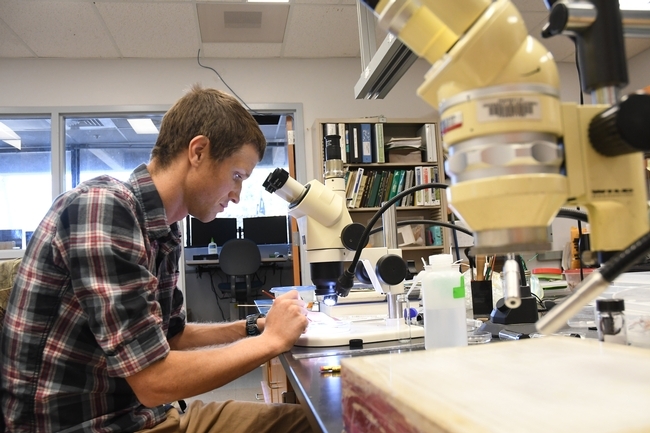
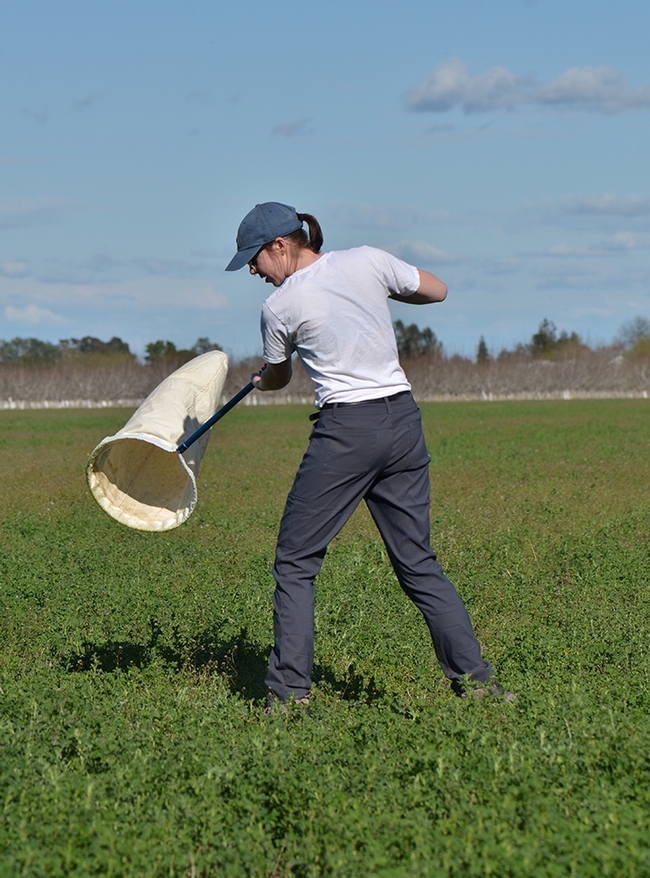
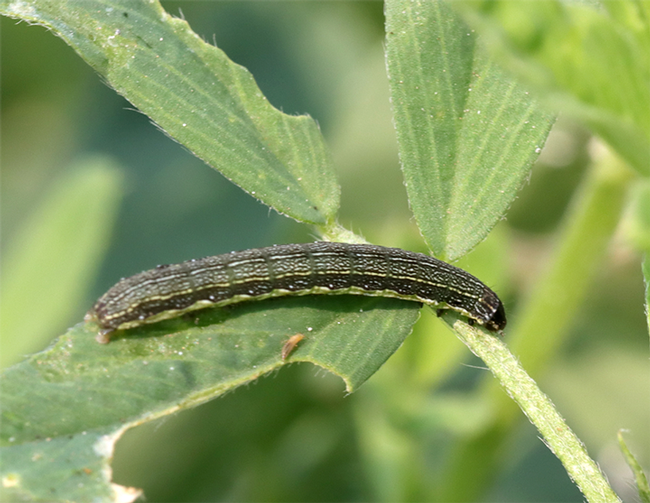
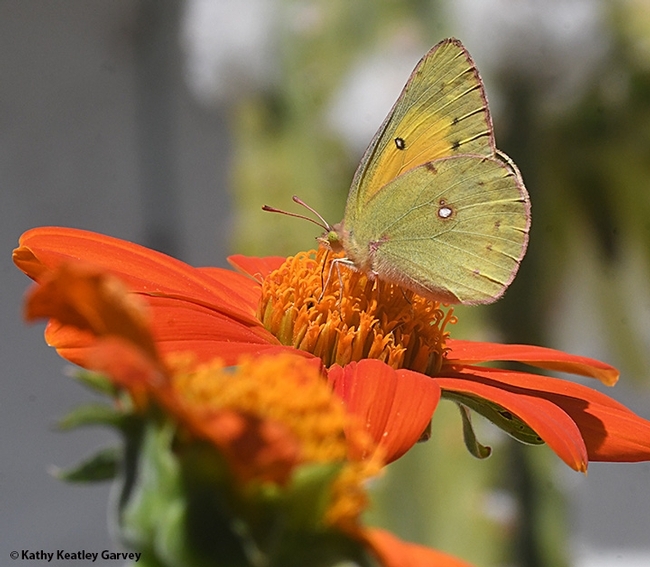
- Author: Kathy Keatley Garvey
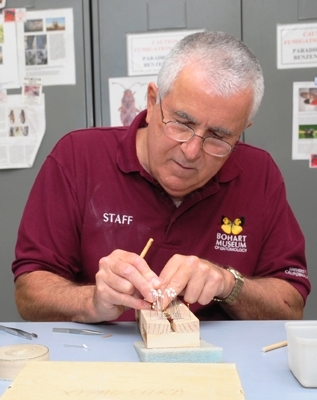
The Bohart Museum will live-stream the free open house on Facebook. Entomologist Jeff Smith, who curates the 500,000 Lepidoptera (butterflies and moths) collection, will show specimens and answer questions.
Due to the COVID-19 pandemic, this is the Bohart Museum's first-ever Virtual Moth Open House.
“We started holding a moth-themed open house near Mother's Day in May, because people who are enthusiasts for moths are called moth-ers,” said Tabatha Yang, education and outreach coordinator for the Bohart Museum. “We then switched our programming to align with National Moth Week. This year's Moth Week is July 18-26. The annual event is celebrated throughout the world with private and public events.
Bohart Museum officials are preparing videos on black-lighting and how to spread and pin moths.
During the Facebook Live program, viewers can type in their questions on moths.
Smith is expected to answer questions such as:
- What is the largest moth?
- How do butterflies and moths differ?
- What is so unique about moths?
- Why should we be concerned with moth diversity?
Smith received a 2015 Friend of the College Award from the UC Davis College of Agricultural and Environmental Sciences for saving the museum some $160,000 over a 27-year period through his volunteer service.
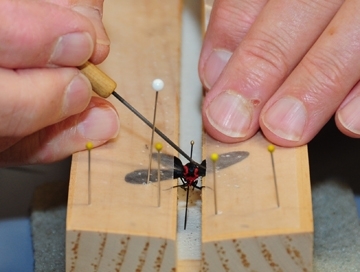
Kimsey, who has directed the museum since 1989, remembers when Smith joined the museum. “When Jeff was working for Univar Environmental Services, a 35-year career until his retirement in 2013, he would spend some of his vacation days at the museum. Over the years Jeff took over more and more of the curation of the butterfly and moth collection. He took home literally thousands of field pinned specimens and spread their wings at home, bringing them back to the museum perfectly mounted. To date he has spread the wings on more than 200,000 butterflies and moths. This translates into something like 33,000 hours of work!” The numbers have since increased.
“About a decade ago, Jeff began helping us by assembling specimen drawers from kits that we purchased,” Kimsey related. “This substantially lowered our curatorial costs, from $50/drawer to $16/drawer. We use several hundred drawers a year to accommodate donated specimens, research vouchers and specimens resulting from research grants and inventories. More recently, he's been accumulating scrap lumber and making the drawers from scratch at no cost to us. Overall, he has made more than 2000 drawers. Additionally, he makes smaller specimen boxes with the leftover scrap wood, which are used by students taking various field courses in the department. We simply could not curate the collection without his contributions.”
Kimsey praised Smith for completely reorganizing the butterfly and moth collection. “It's no small feat to rearrange this many specimens, housed in roughly one thousand drawers,” she said. “Many thousands of the specimens needed to be identified, and the taxonomy required extensive updating and reorganization.”
The Bohart Museum, located in Room 1124 of the Academic Surge Building, Crocker Lane, UC Davis campus, houses a global collection of nearly eight million specimens. It is also the home of the seventh largest insect collection in North America, and the California Insect Survey, a storehouse of the insect biodiversity. Noted entomologist Richard M. Bohart (1913-2007) founded the museum.
Bohart Museum is the home of a “live” petting zoo featuring Madagascar hissing cockroaches, walking sticks and tarantulas, and a gift shop, stocked with T-shirts, sweatshirts, books, jewelry, posters, insect-collecting equipment and insect-themed candy.
Link:
Spreading Wings: The Amazing Work of Bohart Museum Associate Jeff Smith
